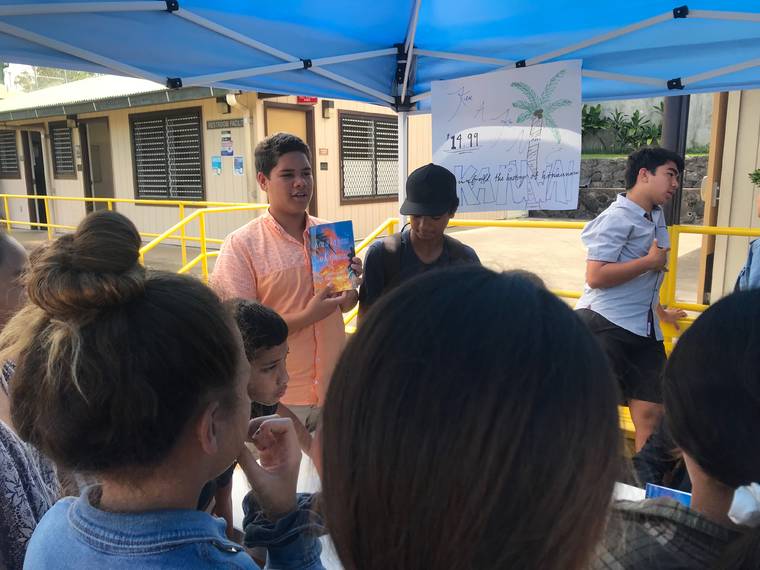KEALAKEKUA — When kumu Shahrazad Ahmed’s ninth graders at Ke Kula o Ehunuikaimalino learned in December they’d be writing a book for class, they had some anxiety about the project.
“At first, we were horrified,” said Minoaka Gifford. “We’re 14 years old! How are we supposed to write a book?”
But after a semester of research, interviews, hard work and service learning, the class celebrated Friday morning with the official launch of “Keu a ka nani o Kapuwai: Unfold the history of Puuhonua o Honaunau,” an exploration into that area’s traditions and stories as well as its plant life, marine life and other natural resources.
“It was actually a really good experience to learn and make it with our classes and learn all the different things that we didn’t know down at Puuhonua,” said Malakai Esperanza. “So honestly the accomplishment that we made is very huge to us, because we made a book that can spread awareness to people and educate them in different stuff they didn’t know.”
The book, which students produced with the help of Hua Aina o Honaunau project coordinator Healani Cahill, ethnobotanist Momi Subiono and kumu Shaftton Kuakai Kaupu-Cabuag, sells for $14.99 and is available through www.lulu.com. A direct link to order the book can be found at https://bit.ly/2HMr032.
“I wanted them to have an experience where they had the opportunity for them to really value what it is that we were receiving,” said Ahmed. “I wanted them to value these stories. I wanted them to value this history. I want them to value their heritage.”
With that, she said, she wanted her students to be able to present those stories while learning valuable research skills.
In addition to the research and interviews students conducted for the book, the project also involved service learning efforts, in which students cleared rocks, coral and other debris away from a punawai and planted endemic species with medicinal value.
Ahmed said she hopes the books can help the class raise funds for future projects or trips over their next three years in school. As a Hawaiian immersion school, Ke Kula o Ehunuikaimalino hosts visitors from throughout Polynesia, she said, and she believes the school needs to reciprocate that and venture to other places in the greater region.
Gifford, 14, said his group focused on the traditions of Hawaii and Puuhonua o Honaunau.
He was familiar with some of those traditions having grown up with them, he said, “but there were so many others at the same time that I didn’t know about.”
“Because there were so many older traditions that we can’t use nowadays because we don’t have the resources, and because it just doesn’t happen anymore,” he said. “Most of these traditions were forgotten by our families, so the fact that I was able to learn them just by going down to the beach was sort of eye-opening.”
Some particularly memorable traditions, he said, focused on coconut trees. Namely, that the felling of one was considered a declaration of war and that families would often commemorate a birth by planting one.
“And I found that really cool,” he said. “Because it was a symbol for that child that they incorporated into their lives.”
Esperanza, meanwhile, spent the semester with his partner focusing on the marine life and the impacts of things like non-reef-safe sunscreens.
He said he hopes the book can be a resource for people, including tourists, to learn something they didn’t know.
“So that accomplishment that we made is a very huge impact to us and to the people who don’t know anything about Hawaii and down Puuhonua,” he said.
Over the course of the project, Ahmed said she witnessed a lot of growth among her students, particularly among those who weren’t entirely on board with the idea at first.
“But over time as we worked on the drafts and as the pairs worked on editing their writing, you began to see that they begin to invest in what they were doing,” she said. “They begin to take ownership of what they were doing. It wasn’t just an assignment; it was a real project.”
While the book offers a chance to explore the stories of Puuhonua o Honaunau, Gifford said the project could potentially spark interest among people to learn more about the traditions and stories of their ancestors.
“So this book was just a way to help people get into it a little bit, and then after they learned about it, maybe inspire them to go to other parts of the islands and learn their traditions,” he said. “Because even though it’s an island and it’s a pretty small one, there’s still so many different traditions everywhere and so many different ways of doing things, that it was amazing that our ancestors were able to come up with them in the first place.”






